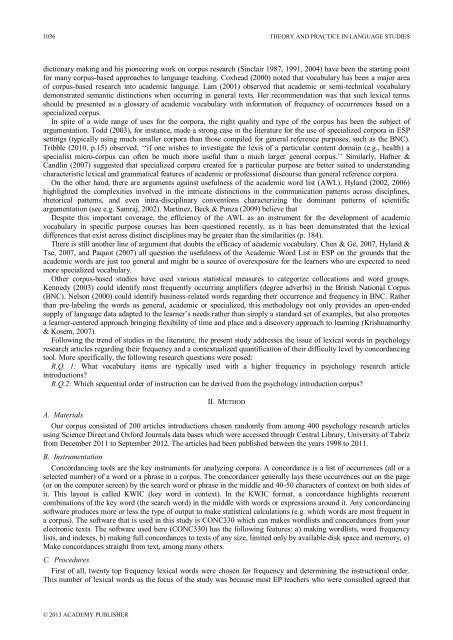Theory and Practice in Language Studies Contents - Academy ...
Theory and Practice in Language Studies Contents - Academy ...
Theory and Practice in Language Studies Contents - Academy ...
Create successful ePaper yourself
Turn your PDF publications into a flip-book with our unique Google optimized e-Paper software.
1036 THEORY AND PRACTICE IN LANGUAGE STUDIESdictionary mak<strong>in</strong>g <strong>and</strong> his pioneer<strong>in</strong>g work on corpus research (S<strong>in</strong>clair 1987, 1991, 2004) have been the start<strong>in</strong>g po<strong>in</strong>tfor many corpus-based approaches to language teach<strong>in</strong>g. Coxhead (2000) noted that vocabulary has been a major areaof corpus-based research <strong>in</strong>to academic language. Lam (2001) observed that academic or semi-technical vocabularydemonstrated semantic dist<strong>in</strong>ctions when occurr<strong>in</strong>g <strong>in</strong> general texts. Her recommendation was that such lexical termsshould be presented as a glossary of academic vocabulary with <strong>in</strong>formation of frequency of occurrences based on aspecialized corpus.In spite of a wide range of uses for the corpora, the right quality <strong>and</strong> type of the corpus has been the subject ofargumentation. Todd (2003), for <strong>in</strong>stance, made a strong case <strong>in</strong> the literature for the use of specialized corpora <strong>in</strong> ESPsett<strong>in</strong>gs (typically us<strong>in</strong>g much smaller corpora than those compiled for general reference purposes, such as the BNC).Tribble (2010, p.15) observed, „„if one wishes to <strong>in</strong>vestigate the lexis of a particular content doma<strong>in</strong> (e.g., health) aspecialist micro-corpus can often be much more useful than a much larger general corpus.‟‟ Similarly, Hafner &C<strong>and</strong>l<strong>in</strong> (2007) suggested that specialized corpora created for a particular purpose are better suited to underst<strong>and</strong><strong>in</strong>gcharacteristic lexical <strong>and</strong> grammatical features of academic or professional discourse than general reference corpora.On the other h<strong>and</strong>, there are arguments aga<strong>in</strong>st usefulness of the academic word list (AWL). Hyl<strong>and</strong> (2002, 2006)highlighted the complexities <strong>in</strong>volved <strong>in</strong> the <strong>in</strong>tricate dist<strong>in</strong>ctions <strong>in</strong> the communication patterns across discipl<strong>in</strong>es,rhetorical patterns, <strong>and</strong> even <strong>in</strong>tra-discipl<strong>in</strong>ary conventions characteriz<strong>in</strong>g the dom<strong>in</strong>ant patterns of scientificargumentation (see e.g. Samraj, 2002). Martínez, Beck & Panza (2009) believe thatDespite this important coverage, the efficiency of the AWL as an <strong>in</strong>strument for the development of academicvocabulary <strong>in</strong> specific purpose courses has been questioned recently, as it has been demonstrated that the lexicaldifferences that exist across dist<strong>in</strong>ct discipl<strong>in</strong>es may be greater than the similarities (p. 184).There is still another l<strong>in</strong>e of argument that doubts the efficacy of academic vocabulary. Chen & Ge, 2007, Hyl<strong>and</strong> &Tse, 2007, <strong>and</strong> Paquot (2007) all question the usefulness of the Academic Word List <strong>in</strong> ESP on the grounds that theacademic words are just too general <strong>and</strong> might be a source of overexposure for the learners who are expected to needmore specialized vocabulary.Other corpus-based studies have used various statistical measures to categorize collocations <strong>and</strong> word groups.Kennedy (2003) could identify most frequently occurr<strong>in</strong>g amplifiers (degree adverbs) <strong>in</strong> the British National Corpus(BNC). Nelson (2000) could identify bus<strong>in</strong>ess-related words regard<strong>in</strong>g their occurrence <strong>and</strong> frequency <strong>in</strong> BNC. Ratherthan pre-label<strong>in</strong>g the words as general, academic or specialized, this methodology not only provides an open-endedsupply of language data adapted to the learner‟s needs rather than simply a st<strong>and</strong>ard set of examples, but also promotesa learner-centered approach br<strong>in</strong>g<strong>in</strong>g flexibility of time <strong>and</strong> place <strong>and</strong> a discovery approach to learn<strong>in</strong>g (Krishnamurthy& Kosem, 2007).Follow<strong>in</strong>g the trend of studies <strong>in</strong> the literature, the present study addresses the issue of lexical words <strong>in</strong> psychologyresearch articles regard<strong>in</strong>g their frequency <strong>and</strong> a contextualized quantification of their difficulty level by concordanc<strong>in</strong>gtool. More specifically, the follow<strong>in</strong>g research questions were posed:R.Q. 1: What vocabulary items are typically used with a higher frequency <strong>in</strong> psychology research article<strong>in</strong>troductions?R.Q.2: Which sequential order of <strong>in</strong>struction can be derived from the psychology <strong>in</strong>troduction corpus?II. METHODA. MaterialsOur corpus consisted of 200 articles <strong>in</strong>troductions chosen r<strong>and</strong>omly from among 400 psychology research articlesus<strong>in</strong>g Science Direct <strong>and</strong> Oxford Journals data bases which were accessed through Central Library, University of Tabrizfrom December 2011 to September 2012. The articles had been published between the years 1998 to 2011.B. InstrumentationConcordanc<strong>in</strong>g tools are the key <strong>in</strong>struments for analyz<strong>in</strong>g corpora. A concordance is a list of occurrences (all or aselected number) of a word or a phrase <strong>in</strong> a corpus. The concordancer generally lays these occurrences out on the page(or on the computer screen) by the search word or phrase <strong>in</strong> the middle <strong>and</strong> 40-50 characters of context on both sides ofit. This layout is called KWIC (key word <strong>in</strong> context). In the KWIC format, a concordance highlights recurrentcomb<strong>in</strong>ations of the key word (the search word) <strong>in</strong> the middle with words or expressions around it. Any concordanc<strong>in</strong>gsoftware produces more or less the type of output to make statistical calculations (e.g. which words are most frequent <strong>in</strong>a corpus). The software that is used <strong>in</strong> this study is CONC330 which can makes wordlists <strong>and</strong> concordances from yourelectronic texts. The software used here (CONC330) has the follow<strong>in</strong>g features: a) mak<strong>in</strong>g wordlists, word frequencylists, <strong>and</strong> <strong>in</strong>dexes, b) mak<strong>in</strong>g full concordances to texts of any size, limited only by available disk space <strong>and</strong> memory, c)Make concordances straight from text, among many others.C. ProceduresFirst of all, twenty top frequency lexical words were chosen for frequency <strong>and</strong> determ<strong>in</strong><strong>in</strong>g the <strong>in</strong>structional order.This number of lexical words as the focus of the study was because most EP teachers who were consulted agreed that© 2013 ACADEMY PUBLISHER
















